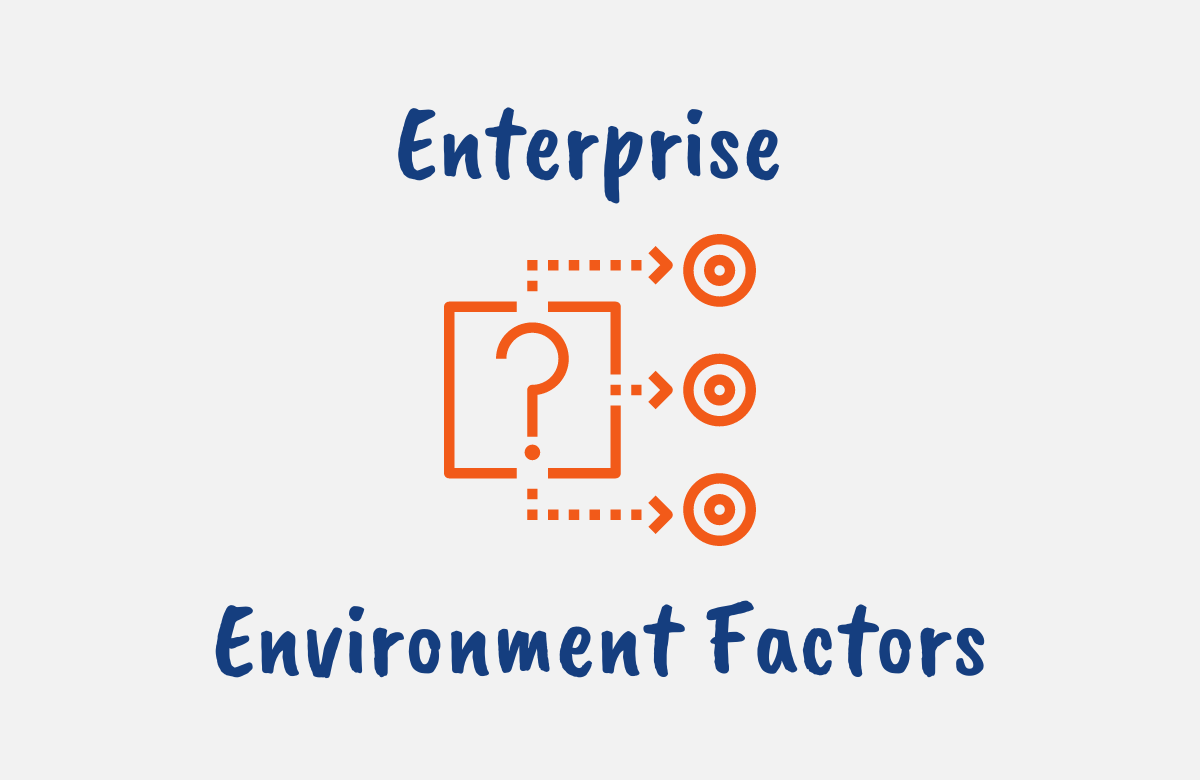Any project that you manage comes with its fair share of constraints. From the iron triangle constraints of scope, schedule, and cost, to quality. These constraints happen to be influenced by Enterprise Environmental Factors (EEFs).
As a project manager, you need to understand how EEFs work, and how they affect your project.
Also, if you are preparing for the PMP exam, EEFs is a concept you must be aware of as it is an input to almost all project management processes.
In this article, we’ll cover what EEFs are all about, the different types, strategies for managing them, and how they differ from Organizational Process Assets (OPAs). We’ll also provide tips on answers PMP exam questions on this topic.
What are Enterprise Environmental Factors in Project Management?
Enterprise Environmental Factors (EEFs) are conditions related to the environment within which the project operates that impact how the project is executed and completed.
They could be internal or external to the organization and encompass anything within the project environment that may constrain or influence the project outcomes that is out of the project team’s control.
Examples include organizational culture and structure, government regulations, resource availability, market conditions, and weather.
As a project manager, you must proactively identify and assess potential EEFs when planning your project to understand how they may influence factors like schedule, cost, scope, quality, resources, and risks.
This way, you can leverage positive EEFs that enable your project while mitigating potential negative impacts from constraining EEFs.
Monitoring EEFs throughout the project lifecycle enables you to adapt plans as the project environment evolves.
| Internal EEFs | External EEFs |
|---|---|
| Organizational Culture, Structure, and Policies | Government Regulations and Policies |
| Available Resources and Infrastructure | Social, Political, and Economic Climate |
| Existing Systems and Procedures | Industry Standards and Trends |
| Project Management Information Systems | Market Conditions and Consumer Preferences |
| Historical Databases | Physical Environment and Weather |
Types of Enterprise Environmental Factors
Enterprise environmental factors can be categorized as either internal or external to the organization.
Internal Environmental Factors
Internal EEFs originate from within the organization executing the project. They include:
1. Organizational Culture, Structure, and Policies
The norms, values, established procedures, and management style within an organization shape the culture.
The reporting structure, departments, and functions represent the organizational structure, and formal guidelines and bylaws comprise organizational policies.
As a project manager, you must operate successfully within the established internal environment defined by the organization’s existing culture, structure, and policies.
2. Available Resources and Infrastructure
These include resources that may impact your project including staffing levels, facilities, equipment, networks, corporate knowledge bases, and intellectual property.
The adequacy of these organizational resources and the current infrastructure to support project needs are key EEFs.
3. Existing Systems and Procedures
These are the standard methodologies, enterprise environmental management systems, stage gate processes for product development, and software development lifecycle models that reflect existing systems used across the organization.
Administrative procedures for budgeting, HR, and procurement are also internal EEFs.
4. Project Management Information Systems
PMIS provides scheduling, cost tracking, document sharing, and other tools to facilitate project management through automated systems and standardized processes.
The PMIS capabilities of your organization are an EEF.
5. Historical Databases
Records of past projects’ performance metrics, risk logs, lessons learned, and process documentation represent historical EEFs you can leverage.
External Environmental Factors
External EEFs originate from outside the organization and are beyond its control. They include:
1. Government Regulations and Policies
Projects must operate within the legal and regulatory framework governing environmental protection, labor, taxes, trade, health, and safety standards.
Changes in governmental regulations and policies can impact project plans.
2. Social, Political, and Economic Climate
Factors like public opinion of an organization or its initiatives, political uncertainty, and macroeconomic trends shape the broader social, political, and economic climate. These in turn influence projects.
3. Industry Standards and Trends
The practices established across an industry, along with shifts in competitive forces, products, and business models comprise the industry landscape within which a project operates.
4. Market Conditions and Consumer Preferences
For projects developing new products and services, target market demographics, size, growth patterns, and customer preferences are important EEFs to analyze.
5. Physical Environment and Weather
Geography, accessibility of project sites, and weather patterns can constrain logistics, schedules, costs, available labor pools, and resources.
Environmental concerns also impact how projects execute operations.
Importance of Considering Enterprise Environmental Factors
Analyzing EEFs enables the development of realistic project plans and the optimization of execution as they happen to:
1. Impact Project Constraints
The core constraints of project scope, schedule, budget, and quality are all directly influenced by EEFs.
Assessing how internal EEFs like organizational resource availability and culture align with your project needs shapes scope and schedule estimates.
External EEFs like market demand and materials costs drive the project’s target budget, while required quality levels and standards are often dictated by both regulatory and organizational policies.
2. Affect Stakeholder Engagement Strategies
Since EEFs evaluate the project environment, they provide insights into the stakeholder landscape and concerns.
This aids you in developing tailored engagement, communication, and expectation management approaches for stakeholders.
3. Influence Procurement and Vendor Approach
Your organization’s contracting and purchasing procedures fall under internal EEFs. These dictate procurement processes.
External EEFs like supplier qualification criteria and availability shape your vendor sourcing strategy.
4. Shape Risk Analysis and Mitigation Planning
Assessing EEFs surfaces potential issues, assumptions, obstacles, and opportunities to create a robust project risk profile.
You can develop targeted mitigation and contingency plans based on the projected impacts of EEFs on project objectives.
Considering EEFs is not an isolated planning exercise. It is an integral part of managing projects successfully through all phases, enabling you to maximize results within a complex project environment.

Strategies for Managing Enterprise Environmental Factors
Once you have identified potential EEFs through various analytical techniques, you can develop response strategies to address them.
1. Identifying Relevant EEFs
Use structured frameworks to assess the project environment and pinpoint applicable EEFs:
PESTLE Analysis
This technique evaluates the political, economic, social, technological, legal, and environmental factors surrounding your project.
SWOT Analysis
Conducting a SWOT analysis examines the internal strengths and weaknesses along with the external opportunities and threats related to the project.
Risk Breakdown Structure
A hierarchical risk breakdown structure helps identify EEFs that may manifest as project risks across multiple categories.
Stakeholder Analysis
Gaining empathy on stakeholder concerns, objectives and perceptions through analysis reveals EEFs that matter most to your project’s human elements.
2. Assessing and Analyzing EEF Influence
Once EEFs are identified, assess their level of impact:
Rating Positive or Negative Impact
Categorize each EEF as an enabler with positive influence or a hindrance with negative influence on the project.
Rating Degree of Impact
Quantify the level of potential impact for each EEF on project success factors.
Assessing the Likelihood of Change
Determine if the EEF is likely to remain stable or evolve during the project lifecycle.
3. Developing Response Strategies
Use EEF analysis to shape your project plans:
Leveraging Positive EEFs
Seek ways to benefit from positive EEFs that empower your project like available resources, technologies, and political support.
Mitigating Negative EEFs
Develop contingency plans to counteract constraining EEFs like budget cuts, regulatory changes, public opposition, and environmental threats.
Monitoring Evolving EEFs
Establish procedures to continually scan for shifts in dynamic EEFs like markets, stakeholder needs, and political priorities. Then refine your plans accordingly.

Enterprise Environmental Factors vs Organizational Process Assets
Similar to Enterprise Environmental Factors (EEFs), Organizational Process Assets (OPAs) play a significant role in shaping your project’s direction and outcomes.
It’s important to know how they differ to understand how they individually impact your project.
Definition
EEFs refer to the conditions external to the project that can significantly impact its execution. They are not under the control of the project team.
OPAs on the other hand are the internal resources of the organization that can influence the project’s execution and are within the control of the organization.
Control
As a project manager, you have little to no control over EEFs and need to strategize to accommodate these factors into your project planning and execution.
OPAs can be controlled, changed, and updated by the organization. They can be utilized according to the requirements of the project.
Influence
EEFs primarily influence the way a project is managed and executed, as they define the environment in which the project operates.
OPAs directly influence the project’s planning, execution, and control, as they provide the necessary tools, processes, and knowledge for managing the project.
Change
EEFs are typically dynamic and can change over time. Project managers need to continuously monitor these changes and adjust the project plan accordingly.
While OPAs can also change over time, they are typically updated in a controlled manner based on the knowledge and experience gained from previous projects.

Enterprise Environmental Factors PMP Exam Tips
Enterprise Environmental Factors (EEFs) are a critical concept in the Project Management Body of Knowledge (PMBOK) guide, and understanding these factors is essential for the PMP certification exam.
EEFs can be outputs of the Close Project process or Phase. During this process, updates to organizational process assets occur, which may include updates to the company’s EEFs.
On the other hand, EEFs serve as inputs to numerous processes across all five Process Groups (Initiating, Planning, Executing, Monitoring & Control, and Closing) in the PMBOK guide.
For instance, in the Initiating Process Group, EEFs are inputs to the “Develop Project Charter” process.
In the Planning Process Group, they are inputs to processes like “Develop Project Management Plan”, “Collect Requirements”, and “Define Scope”, among others.
Tips for the PMP Exam
- Understand the Definition: Recognize what EEFs are and how they affect a project. Remember, these are factors not under the immediate control of the project team. Also, understand the difference between EEFs and OPAs.
- Know their Influence: Understand how EEFs can influence the project’s success and how they can pose risks if not adequately considered.
- Identify EEFs: Be able to identify examples of EEFs in exam questions. The PMP exam may present scenarios where you need to recognize the influence of an EEF.
- Understand their Use: Know which PMBOK processes use EEFs as inputs and remember that these factors can be updated during the “Close Project or Phase” process.
- Practice: Use PMP practice questions to familiarize yourself with how EEFs might appear in exam questions. This practice will help you recognize and correctly respond to these questions on the actual test.
Summary
Enterprise environmental factors are a core part of any project, and actively managing them is a key project management skill.
Leveraging positive factors while mitigating risks from negative factors allows you to optimize project plans.
Master the analysis of external and internal factors out of your control to empower better decision-making.
This creates resilience and enables you to capitalize on emerging opportunities for project success.
FAQs
What Process Provides Enterprise Environmental Factors as an Output?
According to the PMBOK 6th Edition, Enterprise environmental factors updates are outputs of the following processes:
• Acquire Resources
• Develop Team
• Manage Team
What Enterprise Environmental Factors Can Influence a Project?
Enterprise Environmental Factors influencing a project can include organizational culture and structure, market conditions, infrastructure, human resources, stakeholder influence, political climate, and geographical location.
These factors can significantly impact project planning, execution, and outcomes.
Who Controls Enterprise Environmental Factors?
Enterprise Environmental Factors (EEFs) are typically beyond the direct control of a project team. They are influenced by broader organizational, market, and external environmental conditions.
However, project managers need to strategize and plan to accommodate these factors into project execution.
How do You Identify EEFs?
To identify enterprise environmental factors (EEFs), utilize techniques like PESTLE analysis, SWOT analysis, risk breakdown structures, and stakeholder analysis.
These methods help assess the external and internal dimensions around a project to pinpoint relevant EEFs for consideration in planning.





